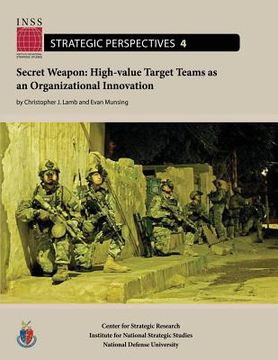Secret Weapon: High-value Target Teams as an Organizational Innovation: Institute for National Strategic Studies, Strategic Perspecti (en Inglés)
Reseña del libro "Secret Weapon: High-value Target Teams as an Organizational Innovation: Institute for National Strategic Studies, Strategic Perspecti (en Inglés)"
This study argues that interagency teams were a major catalyst in turning around the Iraq War, and that they will disappear from America's arsenal unless the knowledge base supporting the innovation can be secured. Most explanations credit the dramatic reduction in violence in Iraq between 2007 and 2008 to new U.S. leadership, the surge in U.S. forces, and/or U.S. financial support to Sunni tribal leaders. In contrast, we argue that the United States employed an underappreciated organizational innovation-interagency teams-to put insurgent clandestine organizations on the defensive and give population security measures a chance to take effect. By the end of 2004, Special Operations Forces (SOF) were using interagency high-value target teams in Iraq that were tactically successful-even awe-inspiring-but they were not making a strategic difference. Meanwhile, Army commanders in Mosul, Tal Afar, and Ramadi demonstrated that the insurgency could be beaten with organizations and tactics capable of conducting classic counterinsurgency warfare. They targeted insurgents and terrorists with sufficient discrimination to put them on the defensive, while population-centric security measures and influence operations pacified the broader population. The SOF and Army commanders used a kind of collaborative warfare that involved three separate innovations, each of which required interagency collaboration and all of which ultimately had to merge into a unified approach. The first innovation was network-based targeting. This meant charting the clandestine terrorist and insurgent cells and their immediate supporters in order to attack them, but also using all-source intelligence to reveal the local environment, its social networks, and key decision makers and their motivations. The second innovation was the fusion of improved all-source intelligence with operational capability. Having intelligence and operations working together in common space on a sustained basis produced persistent surveillance, improved discrimination, and better decision making. The third innovation was the integration of counterterrorist and counterinsurgency efforts and the proliferation of this model. All three innovations-networked-based targeting, fusion of intelligence and operations, and counterterrorist-counterinsurgency integration-required unprecedented collaboration between diverse departments and agencies and between SOF and conventional forces. Together, these innovations set the stage for the dramatic reversal of the security situation in Iraq in 2007. We explain the performance of the interagency high-value target teams using 10 variables often cited in organizational literature as important determinants of team success. The qualitative assessments offered by personnel with direct experience on the teams unanimously underscore the importance of common purpose, clearly delegated authorities, small size and collocation, and a supportive organizational context. Teams that did not develop a sense of common purpose were not able to override interference from parent organizations. When, initially, interagency teams did not benefit from clearly delegated authorities, their performance suffered. When the teams later were clearly empowered, their performance improved, but the issue of ambiguous authorities was a constant source of tension and a major reason for the fragility of the teams' performance. The ability of the teams to learn also was important. SOF did a better job of assessing the second- and third-order effects of their operations and made a greater strategic contribution after learning the importance of expanding their collaboration to include conventional forces. Finally, because departments and agencies could hamstring team performance by withholding support, cajoling parent organizations for support was a major preoccupation of senior leaders in Iraq. The U.S. experience with interagency teams justifies several broader observations.

